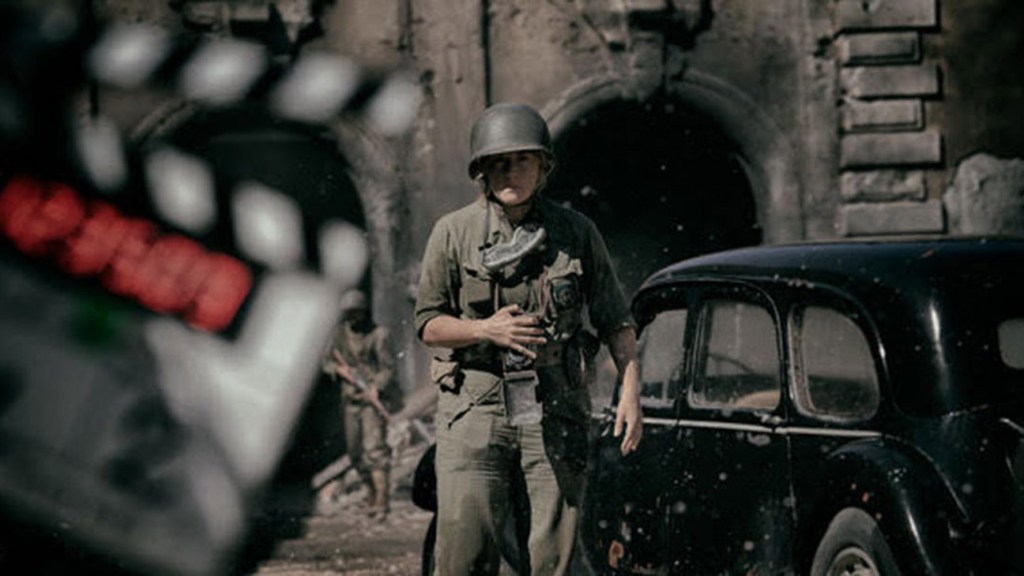
In Lee, Kate Winslet transforms into Lee Miller, a model turned photographer whose World War II images forced those outside of the conflict to confront the brutality of fascism. The actress injects award-winning cinematographer Ellen Kuras’ glossy and conventional biopic with an energy that ushers an enigmatic figure to the foreground.
The real life Miller has had a quiet resurgence in the last few decades. In 2005, Australian writer Carolyn Burke penned a biography that meticulously chronicled Miller’s path to becoming a war photographer. Exhibitions in the U.S. and Britain in 2015 displayed her striking photographs of the Blitz and the aftermath of D-Day. Miller approached her war images with a kind of radical subjectivity, choosing to capture moments of deep empathy and pain. Considering the discomfort her photos inspired, one can only imagine how a firsthand experience of combat textured Miller’s interior life.
Lee
The Bottom Line
A tidy portrait of a complicated subject.
Winslet has this question on her mind, too. Her portrayal of Lee is marked by the subtlety of change, highlighting how trauma can subdue or contort people until they are unrecognizable to themselves. The moving portrayal, at times, scuffs against the glossiness of Lee. Kuras’ film is competent, polished and awards-ready. And while that all makes for a fine viewing experience, the movie also feels at odds with its subject — a restless woman whose passion and hurt drove her to action.
Kuras structures the film as a series of flashbacks initiated by a conversation between an older Lee (also played by Winslet) and a young journalist (Josh O’Connor). It’s 1977 in an English village, where Lee lived in her final years. She’s suspicious of the man sitting across from her who wants to know about her work. “They’re just pictures,” she says.
Lee’s style is plain and matter-of-fact, and the film’s spare and often muted visual language (cinematography is by Pawel Edelman) matches that mood. Taking a sip of her drink, the photographer starts her story in France, 1938, where she spent days lounging in the sun and having lunch with friends. The threat of war loomed in the air with Hitler’s Third Reich gaining more influence, but Lee and her friends didn’t think their lives would change so soon. Back then, Solange (Marion Cotillard), Nusch (Noémie Merlant) and Roland (Alexander Skarsgard) reserved their care for each other.
That sentiment changes when the war comes closer to home. Lee moves back to London with Roland, whom she has taken as a lover in France. Their relationship is fueled, in equal parts, by lust and tenderness. As the war revs up, Lee itches to fight. Liz Hannah (The Post), John Collee (Master and Commander) and Marion Hume’s screenplay moves efficiently through the beats of Lee’s life during these years. The sun-kissed moments in France slip nicely into the bleakness of her days in England.
The film really gets going when Lee starts taking photographs for Vogue. Her editor Audrey (an ace Andrea Riseborough) commissions her to capture the war on the homefront, but Lee yearns to be in the field. She eventually gets to the battleground, using independent methods to become an accredited U.S. journalist. She heads off to Europe alone, but once embedded with the troops she meets David Scherman (Andy Samberg), a LIFE photographer who becomes a friend.
Their relationship helps us understand the extent to which witnessing war changes Lee. Samberg holds his own against Winslet, whose character comes to rely heavily on her friend for comfort and advice. They also help each other take photographs. As much as Lee is a portrait of one chapter in its subject’s life, it is also a process film about capturing images. Edelman trains the camera on moments that would go on to become indelible images, helping audiences understand the surrealist bent of Lee’s vision. She takes photographs of hosiery drying on a line in a woman’s barrack as well as a striking picture of a young girl tortured by Nazis. It’s when Lee looks at that last image that a torrent of memories come back to her. Winslet wears the weight of that emotion in her face, which quivers as her character processes unseen and unknown (to us) traumas.
It’s also both in that moment and in a major revelation tucked into the last act that Lee’s structure, although effective, seems incongruous with its subject. Miller spent her life searching. It was a disordered quest that also lent her photographs a profound clarity. In Lee’s attempt to make Miller’s life more legible, it irons out the contradictions and tidies up a mess that would have made for a spikier, more interesting film.
Full credits
Venue: Toronto International Film Festival (Gala Presentations)
Production companies: Brouhaha Entertainment, Juggle Films
Cast: Kate Winslet, Alexander Skarsgård, Andrea Riseborough, Marion Cotillard, Josh O’Connor, Andy Samberg
Director: Ellen Kuras
Screenwriters: Liz Hannah, John Collee, Marion Hume
Producers: Kate Solomon, Kate Winslet, Troy Lum, Andrew Mason, Marie Savare, Lauren Hantz
Executive producers: Finola Dwyer, P.J. Van Sandwijk, Thorsten Schumacher, Claire Taylor, Julia Stuart, Laura Grange, Lem Dobbs, Liz Hannah, John Collee, Jason Duan, Crystine Zhang, John Hantz, Billy Mulligan, Clare Hardwick
Cinematographer: Pawel Edelman
Production designer: Gemma Jackson
Costume designer: Michael O’Connor
Editor: Mikkel Nielsen
Composer: Alexandre Desplat
Casting directors: Katalin Baranyi, Lucy Bevan, Olivia Grant
Sales: CAA
In English, French
1 hour 56 minutes













